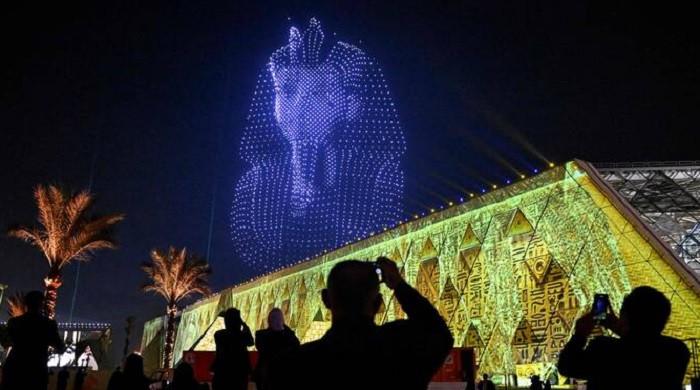Prime ministers, presidents and royalty arrived in Cairo on Saturday to witness the glitzy inauguration of a sprawling new museum built near the pyramids to house one of the world’s richest collections of antiquities.
The inauguration of the $1 billion Grand Egyptian Museum, or GEM, marks the end of a two-decade construction effort hampered by the Arab Spring uprisings, pandemic and wars in neighboring countries.
“We all dreamed about this project and whether it would really come true,” Prime Minister Mostafa Madbouly said at a news conference, calling the museum a “gift from Egypt to the whole world from a country whose history goes back more than 7,000 years.”
Spectators, including President Abdel Fattah al-Sisi, gathered late Saturday in front of a huge screen outside the museum, which projected images of the country’s most famous cultural sites, while dancers in glittering pharaonic-style costumes waved glowing orbs and sceptres.
‘New chapter for Egypt’
They were accompanied by Egyptian pop stars and an international orchestra decked out in white under a sky lit up with lasers, fireworks and floating lights that turned into moving hieroglyphs.
By opening the museum, Egypt was “writing a new chapter in the history of this ancient nation’s present and future,” Sisi said at the opening.
The audience included German President Frank-Walter Steinmeier, Dutch Prime Minister Dick Schoof, Hungarian Prime Minister Viktor Orban, Palestinian President Mahmoud Abbas, Democratic Republic of Congo President Felix Tshisekedi and the crown princes of Oman and Bahrain.
The museum’s most promoted attraction is the extensive collection of treasures from Tutankhamun’s tomb, which was uncovered in 1922, including the boy king’s golden burial mask, throne and sarcophagus, and thousands of other items.
A colossal statue of Ramses II, which sat for decades in a central Cairo square bearing the pharaoh’s name, now graces the grand entrance.
The complex’s sleek design, evoking the pyramids, cuts a stark contrast to the dusty and often out-of-date exhibits of the neoclassical Egyptian Museum, which opened over a century ago in central Cairo overlooking Tahrir Square.
Old museum looted
The ancient museum has suffered insults in recent years, including the looting of several display cases during Egypt’s 2011 uprising, when antiquities theft was rampant.
In 2014, the beard on Tutankhamun’s tomb mask broke off when workers changed the lights in the display case, and was then clumsily glued back on. The following year, the mask was more properly restored and put back on display.
Officials hope the new museum can end a perception fueled by such events that Egypt has been remiss in looking after its priceless treasures, and emphasize its demands that Egyptian objects held in museums abroad be returned.
“Is it a national shrine or a global showcase? A gesture of cultural sovereignty or a tool of soft power?” read an article in a special edition of the state-run Al-Ahram Weekly devoted to the museum, which it called “a philosophy as much as it is a building.”
“GEM is not a copy of the Louvre or the British Museum. It is Egypt’s answer to both. These museums were born of empire; this is born of authenticity.”
The museum’s more than $1 billion price tag was financed in large part by Japanese development loans. Designed by an Irish firm, Heneghan Peng Architects, it covers about 120 acres, making it roughly the same size as Vatican City.
Officials are also betting that the museum, the latest in a series of megaprojects launched or completed since 2014, could spur a revival in tourism, a vital source of foreign exchange for an economy battered by years of regional conflict and economic uncertainty.
A number of galleries had been opened at the end of last year, but many exhibitions were not available to the public.



